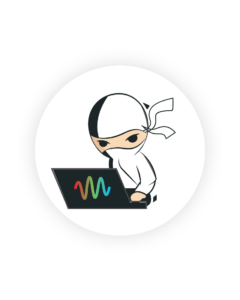
Dec 21, 2020
5 Lessons on Using Customer Sentiment Analysis to Improve Satisfaction
Customer SupportB2B supportcollaborationremote teams
Last week, SupportLogic co-hosted a webinar with John Ragsdale, Distinguished Research VP at TSIA, on an important topic for customer support and success leaders, How to Use Real-Time Signals to Improve Customer Satisfaction.
Joining John were two SupportLogic customers, Tanvir Kherada, Sr. Director of Technical Solutions at Databricks, and Daniel Coullet, VP of Support Services at Qlik, as well as Krishna Raj Raja, Founder and CEO of SupportLogic. Here are five lessons from using real-time customer sentiment analysis to improve satisfaction:
1. Proactive support is paramount for customer success in the experience economy
Customers today demand instant gratification and can churn at any time. Important decisions around how best to serve them must be made in real-time. Yet many companies still operate on a quarterly decision cycle of conducting surveys, analyzing and sharing the results. What happens during those months of data collection and analysis is that customers are being lost.
Tanvir shared that by the time support teams typically react and do something with customer feedback it’s too late. But now with real-time sentiment analysis, there’s a window while a ticket is still open to actively address the most critical issues. With real-time intelligence, an organization can get a ticket to the right support engineer, better understand where a customer needs the most help and bring in the right resources while it still matters.
Qlik’s own product enables their customers to get insights from data and make smarter decisions, so as a support organization, they have a high bar to meet. Daniel shared that Qlik’s focus on using sentiment analysis has helped to manage customer escalations and become more proactive in addressing customer issues. Sentiment and attention scores provide Qlik with clear signals when customers are in danger of not renewing.
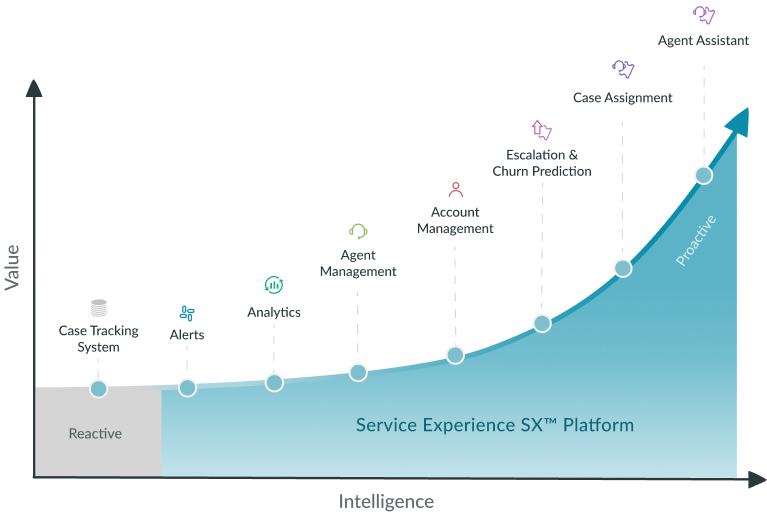
John added that the pandemic this year has pushed companies to be more empathic with customers. He said, “If you’re reactive it will be felt more strongly than ever.”
2. Customer surveys alone are insufficient to enable proactive support
Most support organizations rely on CSAT and NPS as key performance indicators (KPIs) and they’re all lagging measurements. According to 2020 TSIA research that John shared, 81% of companies use CX (customer experience) analytics software, which sounds promising, but 38% of those organizations are only using survey tools, which aren’t really helping companies identify customer issues, nor enable proactively addressing them. Yet, 80% of support and service organizations do have a budget for customer experience initiatives in the next 1-2 years so there are resources available to invest here.
We polled the webinar audience (100 live attendees) on their plans to evolve their Voice of the Customer programs beyond surveys to using real-time sentiment analysis with AI and NLP. 48% of respondents said they plan to add these technologies, while 24% are already using them today.
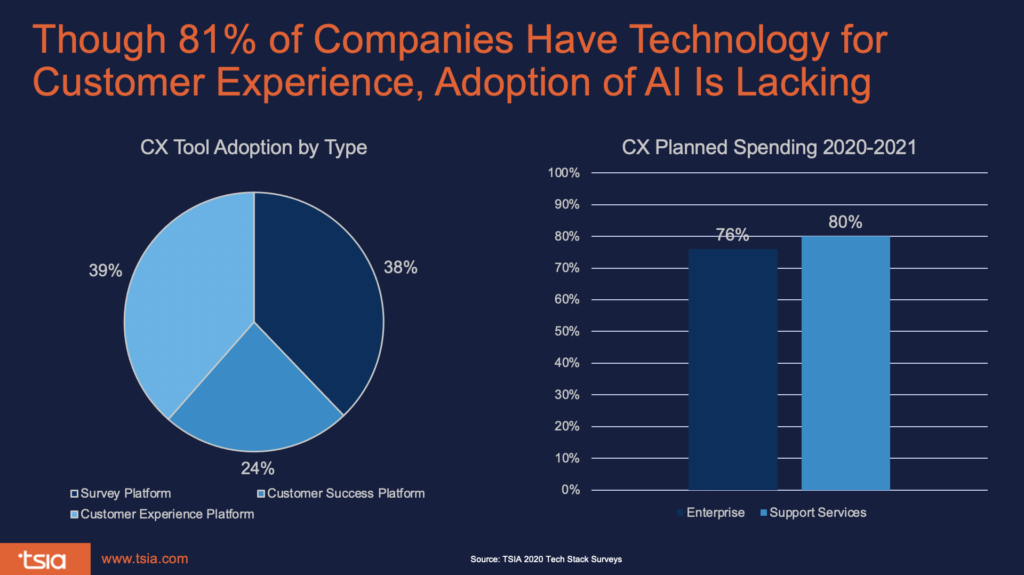
3. Managing real-time customer sentiment analysis is now a critical part of the support operations tech stack
Both Tanvir and Daniel shared their support tech stacks, that include applications for CRM, ticketing for support and engineering, telephony and voice integration, collaboration and community. Each of these pieces is expected, of course, but what’s fairly new is the inclusion of AI-based customer sentiment analysis as a critical capability. Both Qlik and Databricks rely on SupportLogic for this piece.
Ticketing systems alone are limited for enabling proactive support. Krishna shared that while many companies evolve from email support to a ticketing system as they grow, the technology journey typically ends there. Ticketing systems are designed to be a system of record for capturing and storing structured customer information but are not good for proactive support since they can’t handle the unstructured data where the true sentiment signals live.
Furthermore, ticketing systems don’t enable tight collaboration between support and their cross-functional partner teams like engineering, product and customer success. Software development is now agile, with many companies shipping features every week compared to an annual basis not too long ago. Today, real-time analysis is crucial for not only preserving customer experience but for preserving customers.
4. Building your own sentiment analysis tool is sometimes the first approach but not the optimal way
Tanvir shared that Databricks’ sought to utilize real-time signals to provide more meaningful customer insight and improve the operational efficiency of the support team. As an experienced data company, they initially decided to build a sentiment analysis tool but it rendered many false positives and ended up wasting precious internal resource cycles. As their support volume quickly grew to 14,000+ cases per year, they looked for AI-based solutions that integrated well with their different sources of unstructured and structured data and then processed and analyzed the signals to act quickly. They ultimately partnered with SupportLogic and the implementation process was incredibly easy. They set up a connector to Salesforce and started streaming signals almost immediately.
An additional benefit of partnering with a domain expert is to leverage their speed of innovation. Tanvir said he and the Databricks team are really excited about expanding their use of Supportlogic in 2021 to manage intelligent case assignment. Databricks has observed that when you have the right support engineers handing the ticket with the technology skills most relevant to the customer needs, the customer gets the best outcome and it’s win-win.
Daniel shared that AI-based solutions need to be introduced step-by-step so the organization can manage the process changes. Partnering with SupportLogic has enabled Qlik to realize a fast time to value. They have reduced customer escalations by 30% in 6 months, which was a significant win for the team. He added that SupportLogic has been easy to deploy and integrate into their own processes. In 2021 they plan to expand their use of SupportLogic for intelligent agent management and intelligent customer management.
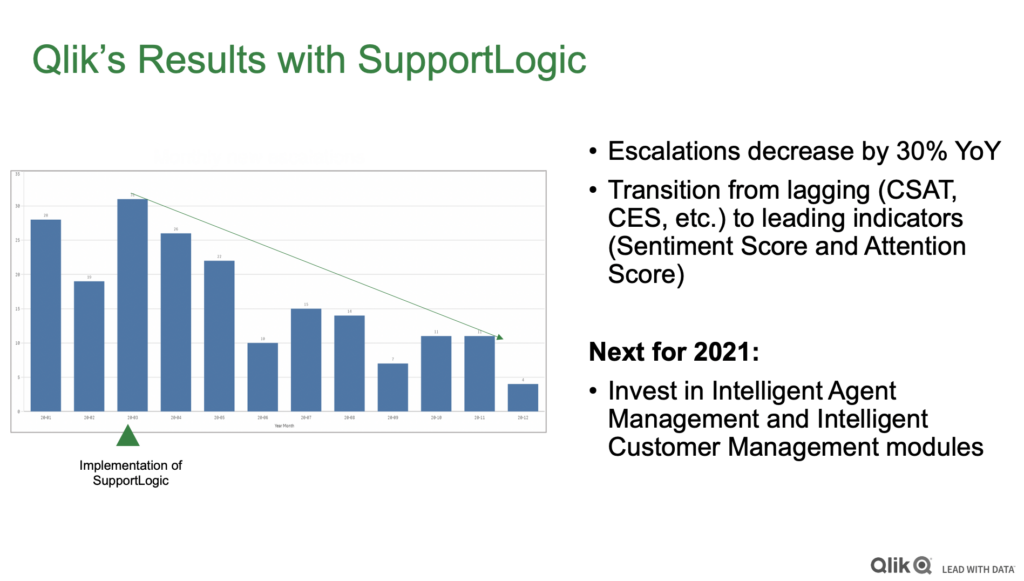
John added that he frequently speaks to TSIA members who try to analyze unstructured data manually by reading through and scoring case notes. He said that it ends up being really painful and is not a scalable solution to this problem.
5. Real-time customer sentiment analysis benefits extend beyond just improving the immediate experience of customers during support interactions
Krishna, who was a support engineer early in his career, shared that the promise of utilizing real-time customer signals is all about transforming the day-to-day interactions support engineers have with their customers. The ability to harness those signals can positively transform how a company develops products, prioritize bugs, delivers delightful customer experiences and how it manages customer churn.
All of the knowledge that’s key to this transformation is hidden in support conversations as unstructured data. Now we finally have the AI technology available to handle the influx of this unstructured data, process it at scale, and turn it into insight that drives immediate action.
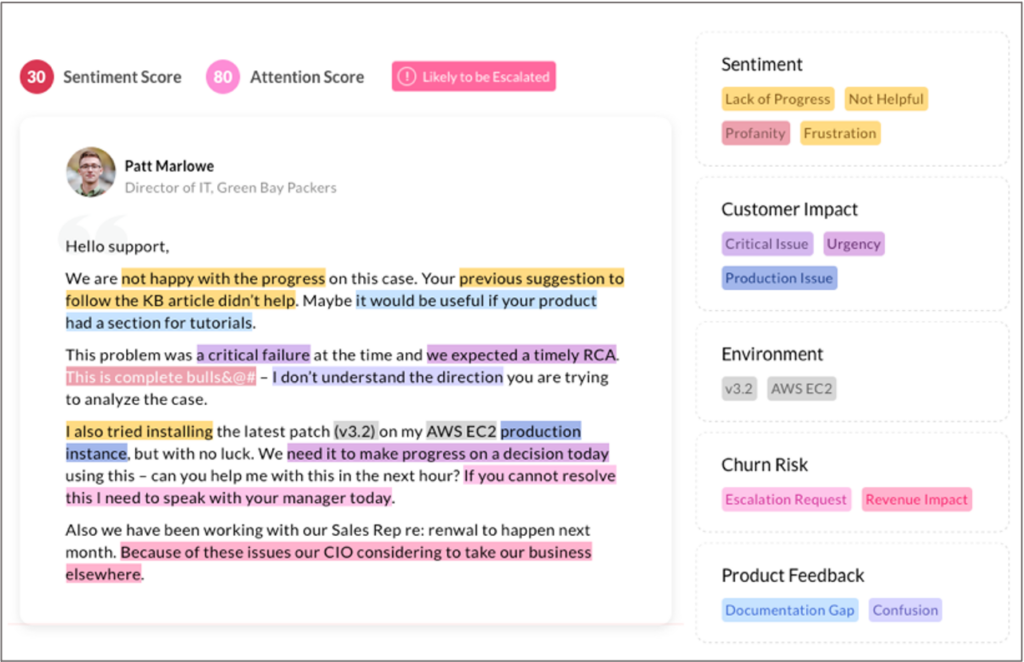
Even a simple support ticket contains numerous signals. What’s needed in your technology stack is the ability to extract those signals and support workflows that proactively address customer needs. Furthermore, these signals are useful to any function in the company. The challenge in the past has been how to extract these signals in a simple, effective way and proactively notify the right people so they’re in the loop. Often engineering and sales only get notified that the case has been escalated when it’s too late.
How to learn more:
If you weren’t able to attend the live webinar, you can see it on demand here.
As you think about your plans for investing in your support organizational capabilities in 2021, let’s explore how SupportLogic can help. We can provide consultative guidance based on the learning from our customers.
SupportLogic is easy to try and we’re currently offering a limited time promotion for our intelligent predictive alerts package, which is a great way to start with SupportLogic and see quick value for your company.
Happy holidays and best wishes to become more real-time in 2021.
Joe leads marketing at SupportLogic and can be reached at joe@supportlogic.io.
Don’t miss out
Want the latest B2B Support, AI and ML blogs delivered straight to your inbox?


